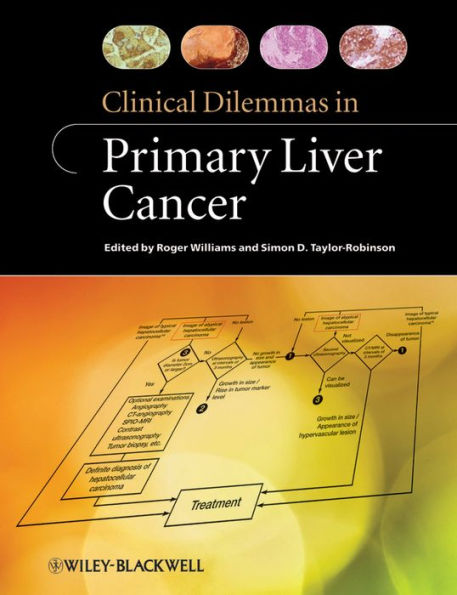
Clinical Dilemmas in Primary Liver Cancer
232
Clinical Dilemmas in Primary Liver Cancer
232Overview
Chapters feature up-to-date information on the basic mechanisms, epidemiological risk factors, screening and surveillance strategies, diagnosis and treatment. It is an extremely practical and clinically-orientated book, and as most patients around the world present with advanced disease, a main focus is on the most recent advances allowing early diagnosis and use of locoregional and systemic therapy, surgery, transplantation and combination therapies. Each chapter is authored by an international expert in the relevant area.

Product Details
| ISBN-13: | 9781119962182 |
|---|---|
| Publisher: | Wiley |
| Publication date: | 11/03/2011 |
| Series: | Clinical Dilemmas (UK) , #6 |
| Sold by: | JOHN WILEY & SONS |
| Format: | eBook |
| Pages: | 232 |
| File size: | 2 MB |
About the Author
Professor Simon Taylor-Robinson joined the Department of Medicine at Imperial College London in 1997, having previously been Senior Registrar in Gastroenterology and Hepatology at Hammersmith Hospital. He was awarded the Sir Francis Avery Jones Gold Medal by the British Society of Gastroenterology in 1999 and the Young Investigator Award of the Liver Section of the European Gastroenterology Association in 1997. He is currently Director of the Imperial Clinical Research Facility at St Mary's Hospital, London.
Read an Excerpt
Table of Contents
List of Contributors, vii
Preface, x
Part 1: Learning from a Worldwide Perspective
1 Are patterns and prevalence changing?, 3
Hashem B. El-Serag
2 Why is the tumour different in Africa?, 11
Nimzing G. Ladep
3 Control by vaccination: Asian and Taiwan experience, 18
Jia-Horng Kao
4 The view from the United Kingdom, 24
Shahid A. Khan, Mireille B. Toledano, Abigail Zabron, Mehtan Ahmed, and Simon D. Taylor-Robinson
5 The view from the United States, 29
Hitoshi Maruyama and Arun J. Sanyal
6 New challenges of the NAFLD and HIV epidemics, 35
Quentin M. Anstee and Janice Main
Part 2: Influence of Tumour Characteristics
7 Controversies in pathology, 45
Tania Roskams
8 Not to forget the unusual tumour, 53
Bernard C. Portmann
9 What can be learned from molecular diagnostic techniques and genetic signatures?, 60
Tariq Moatter and Saeed Hamid
Part 3: Complexities of Patient Assessment and Scoring Systems
10 Looking after the liver as well as the tumour, 67
Roger Williams
11 Comparative performances of staging systems for hepatocellular cancer: early HCC considerations, 75
Peter D. Peng and Timothy M. Pawlik
12 Rival scoring systems: do they offer more?, 81
Angelo Sangiovanni and Massimo Colombo
13 Is it possible to detect early lesions effectively?, 91
Ryota Masuzaki and Masao Omata
14 What is the value of country-based surveillance programmes?, 97
Peter Ott
Part 4: Choice of Radiological Diagnostic Technique
15 Computed tomography or magnetic resonance imaging for the diagnosis of hepatocellular carcinoma, 107
Wladyslaw Gedroyc
16 Is Microbubble ultrasound useful?, 114
Adrian Lim
17 Value of PET scanning, 118
Tara D. Barwick, Imene Zerizer, and Adil Al-Nahhas
Part 5: Can Treatment be Tailored to the Patient?
18 Who could benefit from chemoembolisation?, 127
Gisele N'Kontchou, Olivier Seror, and Michel Beaugrand
19 Are drug-eluting beads worth using?, 136
Christopher N. Hacking and Pradesh Kumar
20 What is the future of image-guided radiofrequency ablation for hepatocellular carcinoma?, 142
Riccardo Lencioni
21 Alternative ablation techniques for hepatocellular carcinoma, 149
John Karani
22 Justification for sorafenib and chemotherapy, 154
Philip J. Johnson
23 When to consider surgery?, 160
Emmanuel Melloul, Mickael Lesurtel, and Pierre-Alain Clavien
24 Transplant considerations, 168
Myron Schwartz
Part 6: What Does the Future Hold?
25 Dipstick markers for diagnosis: feasible or not?, 179
Mohamed I.F. Shariff and Simon D. Taylor-Robinson
26 Targeted gene therapy for hepatocellular carcinoma: a reality?, 184
Christopher Binny, Marco Della Peruta, and Amit C. Nathwani
27 Is immune modulation a possibility?, 191
Tim F. Greten and Firouzeh Korangy
28 Systemic therapy for hepatocellular carcinoma: future directions, 199
Daniel H. Palmer, Matthew E. Cramp
Index, 212
Colour plate section can be found facing page 86
